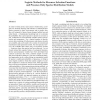Free Online Productivity Tools
i2Speak
i2Symbol
i2OCR
iTex2Img
iWeb2Print
iWeb2Shot
i2Type
iPdf2Split
iPdf2Merge
i2Bopomofo
i2Arabic
i2Style
i2Image
i2PDF
iLatex2Rtf
Sci2ools
AAAI
2011
2011
Logistic Methods for Resource Selection Functions and Presence-Only Species Distribution Models
In order to better protect and conserve biodiversity, ecologists use machine learning and statistics to understand how species respond to their environment and to predict how they will respond to future climate change, habitat loss and other threats. A fundamental modeling task is to estimate the probability that a given species is present in (or uses) a site, conditional on environmental variables such as precipitation and temperature. For a limited number of species, survey data consisting of both presence and absence records are available, and can be used to fit a variety of conventional classification and regression models. For most species, however, the available data consist only of occurrence records — locations where the species has been observed. In two closely-related but separate bodies of ecological literature, diverse special-purpose models have been developed that contrast occurrence data with a random sample of available environmental conditions. The most widespread...
Related Content
| Added | 12 Dec 2011 |
| Updated | 12 Dec 2011 |
| Type | Journal |
| Year | 2011 |
| Where | AAAI |
| Authors | Steven Phillips, Jane Elith |
Comments (0)

